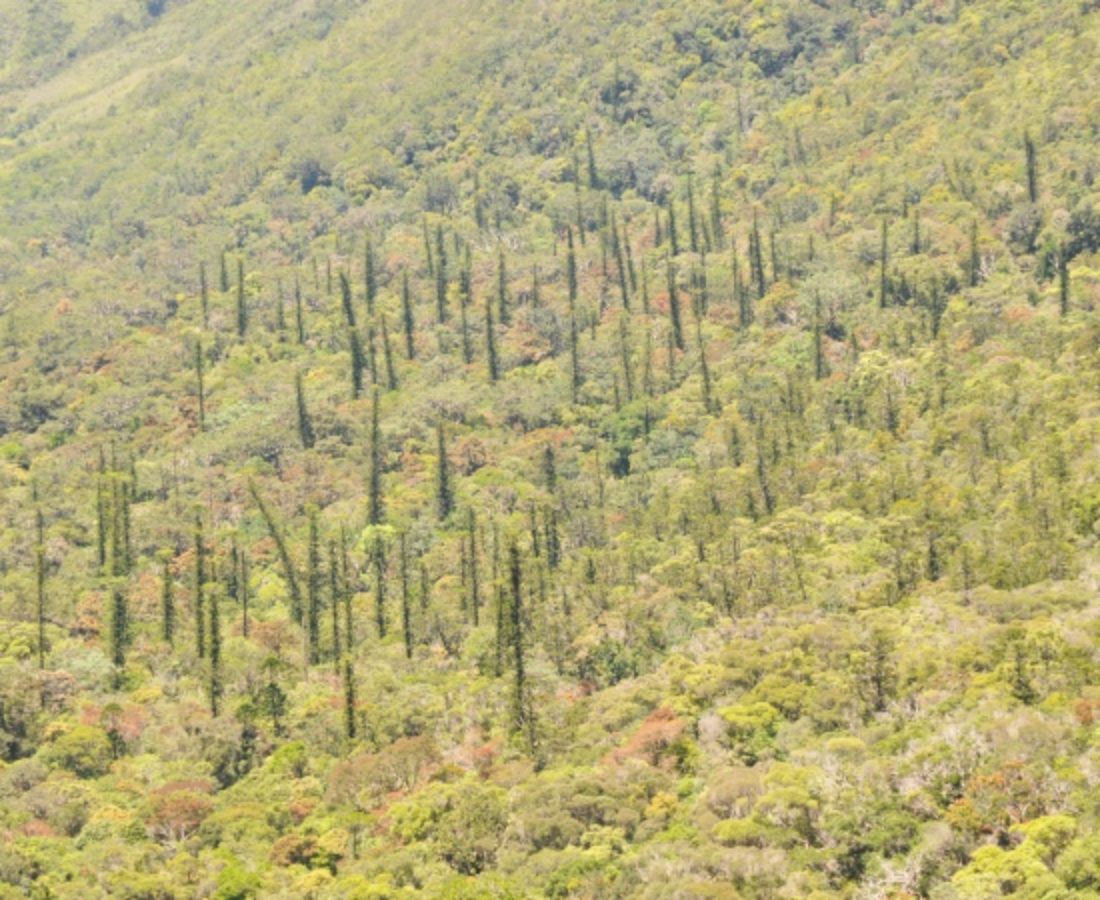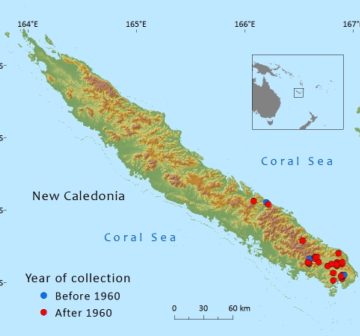Araucariaceae
Araucaria bernieri
One of 13 species of Araucaria endemic to New Caledonia where it occurs on the main island of Grande Terre. It has become much reduced due to logging but present-day threats include fire and mining activities.
Description
Habit
Monoecious tree to 50m tall (sometimes bifurcating), to 1m d.b.h. at maturity; trunk straight or curved. Crown In mature trees columnar but open, branched along the greater part of the trunk, apex rounded or truncated, often wider than the lower crown. Bark on trunks of mature trees to 3cm thick, exfoliating in horizontal strips, forming horizontal bands or ridges; inner bark dark reddish brown; outer bark grey or brown.
Foliage
Adult leaves broadly ovate, 2.5–4.7 × 1.5–2.5mm, 3-edged and incurved with acute or obtuse apex, leathery and smooth, prominently keeled beneath. Stomata on adult leaves, on the underside restricted to the proximal part of the leaf in depressions either side of the keel; on upper surface the stomata are numerous in rows from just above the base to the apex.
Cones
Male pollen-cones 35–45 × 8.5–10mm, terminal, initially erect but pendulous when shedding pollen, light brown with glaucous bloom, cylindrical, confined to higher parts of tree on primary branches. Female seed-cones 8–10 × 6.5–8cm, terminal on short, usually solitary, sometimes 2–3 together, erect, green when mature, subglobose. Bracts 25–30 × 20–25mm including rounded, thin membranous wings, ending in a caudate, slightly curved, 6–8mm long bract tip.
Taxonomic note
A. bernieri var. pumilio Silba was described in 2000 based on specimens collected from the Tiebaghi massif in the northern part of New Caledonia. These specimens have since been redetermined as Araucaria scopulorum. Other specimens from Poum and Tiebaghi that are cited in the Flore de la Nouvelle-Calédonie et dépendances (de Laubenfels, 1972) have also been re-identified as Araucaria scopulorum.
References and further reading
- de Laubenfels, D. J. (1972). Gymnospermes. In: Aubréville, A. & Leroy, J.-F. (eds.), Flore de la Nouvelle-Calédonie et Dépendances, 4. Paris: Muséum National d’Histoire Naturelle. 167 p.
- Gaudeul, M., Rouhan, G., Gardner, M.F. & Hollingsworth, P.M. (2012). AFLP markers provide insights into the evolutionary relationships and diversification of New Caledonian Araucaria species (Araucariaceae). American Journal of Botany. 99(1):68-81.
- Jaffré, T., Bouchet, P. & Veillon, J.–M. (1998). Threatened plants of New Caledonia: Is the system of protected areas adequate? Biodiversity & Conservation 7(1): 36.
- Jaffré, T., Munzinger, J. & Lowry, P.P. (2010). Threats to the conifer species found on New Caledonia's ultramafic massifs and proposals for urgently needed measures to improve their protection. Biodiversity & Conservation: 19(5):1485-1502.
- Manauté, J., Jaffré, T., Veillon, J.–M. & Kranitz, M. (2003). Revue des Araucariaceae de Nouvelle-Calédonie. IRD, Nouméa
- Nasi, R. (1982). Essai pour une meilleure connaissance et une meilleure comprehension des Araucariacées dans la végétation Calédonienne. Nouméa: École Nationale des Ingénieurs des Travaux des Eaux et Forêts, Centre Technique Forestier Tropical. 134 p., 10 plates, 44 p. appendices.
- Thomas, P. (2010). Araucaria bernieri. In: IUCN 2012. IUCN Red List of Threatened Species. Version 2012.1. www.iucnredlist.org . Downloaded on 20 June 2012.









